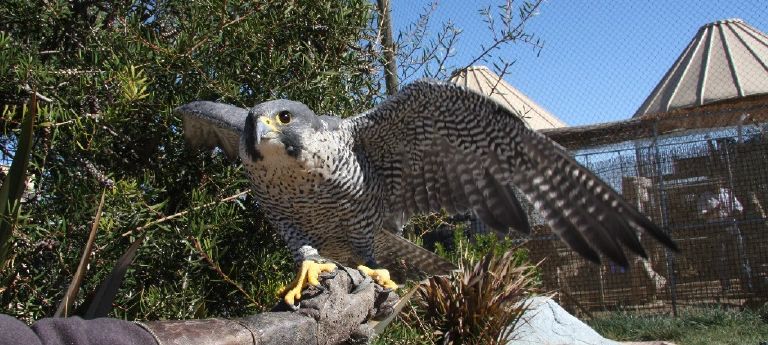PEREGRINE FALCON


FACTS ABOUT THE PEREGRINE FALCON
- The peregrine falcon's scientific name is Falco peregrinus, which means "falcon wanderer".
- Three subspecies are recognized in North America: F.p. pealei from the coastal islands off Alaska; F.p. tundrius, which nests above the tree line in the Arctic; and F.p. anatum, which once ranged over North America from coast to coast.
- Peregrine falcons are about the size and weight of a crow.
- Peregrines normally grow to 15 inches in length with a 40-inch wingspan.
- The speed of a peregrine has been said to reach 175 miles per hour or more. Experiments conducted by scientists put the bird's diving speed at approximately 82 miles per hour and level flight at approximately 62 miles per hour.
- Females are larger and more powerful than males. Adults have slate dark blue-gray wings and backs barred with black, pale undersides, white faces with a black stripe on each cheek, and large, dark eyes. Their wings are long and pointed.
- Their prey includes ducks, pheasants, and pigeons. Biologists are frequently surprised by the variety of species brought to Ohio nests. Remains of meadowlarks, chimney swifts, and woodcock show that falcons find many different birds in their urban surroundings.
- Prey is caught in flight. Using its great speed, the falcon delivers a powerful blow to its prey with a half-closed foot. It retrieves the dead bird either in mid-air or after it falls to the ground.
- Although they have a high mortality rate, peregrines have been known to live as long as 15 years.
- They usually begin breeding at about two years old.
- The nest itself is little more than a shallow scrape, shaped by the birds in soil or accumulated debris. Wildlife biologists frequently provide a gravel-filled tray for city-nesting birds to use.
- The nest holds three or four eggs (slightly smaller than those laid by chickens) that are mottled with a dark, reddish-brown pigment. The eggs hatch in about 33 days.
- Both adults incubate the eggs.
- A young falcon in the nest is called a nestling or an eyas (pronounced I-es). They are covered by white down when they hatch, which is replaced by feathers in three to five weeks.
- Both the adult male and female help care for the nestlings.
- Nestlings eat an incredible amount of food. They double their weight in only six days and at three weeks will be ten times birth size.
- When the young falcons are 3 weeks old, Division of Wildlife biologists examine the birds to determine their sex and take a blood sample used to track DNA and possible chemical contaminants. Biologists also equip each bird with metal leg bands that are used to identify the falcons in the future.
- Around forty days, young peregrines begin flying. Adult peregrines encourage flight by "baiting" the young with food, which is no longer fed directly to the young.
- The young falcons leave the area where they hatched by the end of summer to disperse and establish a territory of their own, elsewhere.
Falcons in the United States- In the 1960s, scientists discovered that a pesticide called DDT was interfering in the egg shell formation of meat and fish eating birds. Healthy birds were laying eggs so thin they were crushed by the weight of the incubating adult.
- By 1965, no peregrine falcons were fledged in the eastern or Central United States.
- By 1968, the peregrine population was completely eradicated east of the Mississippi River.
- In 1972, use of DDT was severely restricted in the United States and worldwide.
- In 1979, the Eastern Peregrine Recovery Plan was developed to restore a peregrine population to the eastern United States.
- Peregrine falcons are a threatened species in Ohio.
- Traditionally, they nested on ledges of high cliffs in remote areas. In cities, they use niches along ledges, such as inset windows or window boxes.
Ref: The Ohio Dept. of Natural Resources (www.ohiodnr.com)








